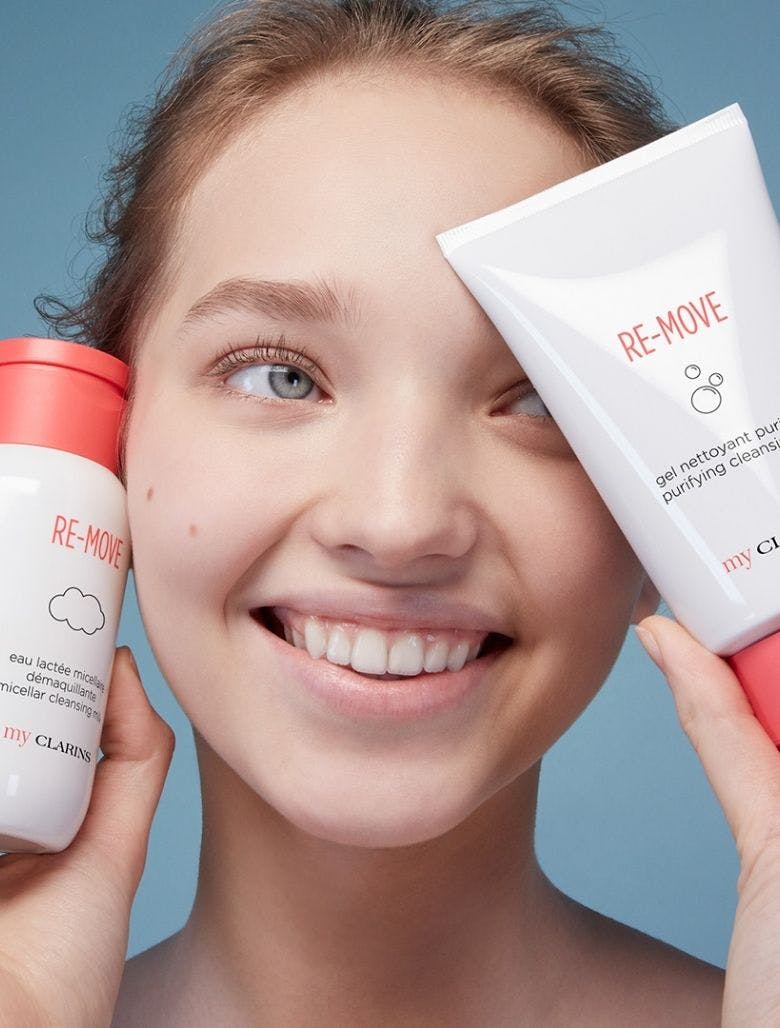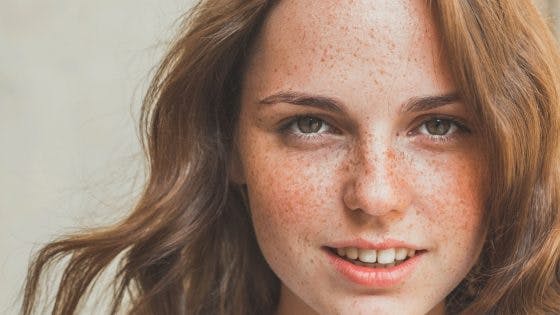Teen Skincare Routine For Clear, Healthy Skin
7 minutes read
Ever wondered what the deal is with teen skincare products? If you’re a teenager, we get it. There’s so much to deal with – especially everyone’s opinions – from Switch time to shoes, school and skincare – there’s always someone ‘just sayin’ whether that’s the adults or the influencers on TikTok.
Rest assured, though, if you read on – ‘teen skincare’ will be the least of your worries: consider it sorted.
Common teenage skin problems
Acne
Well, hello blemishes, where did you spring from? Yep, pesky pimples can appear out of nowhere, and your self-confidence can dip.
Over the past couple of years, the #acneisnormal campaign has normalised it with bloggers like photographer, Peter DeVito and Em Ford’s mypaleskinblog, showing the real, unretouched skin.
So what can you do? We have all the answers to common teen skincare problems, so read on.
Approximately 85% of people aged between 12 and 24 experience some form of acne. Some teens experience occasional outbreaks – these often happen to girls before each menstrual cycle and hormonal fluctuations in guys. For others, acne can become a bit more of a regular condition.
“Acne usually develops in the central area of the cheeks and on the forehead, and it’s almost universally caused by a hormone imbalance or a hypersensitivity to the robust hormonal activity going on the body during this time,” says Dr Doris J Day, author of the book 100 Questions and Answers About Acne.
Skincare for teens
You’re not alone – these common skin problems affect everyone going through puberty. Here’s some advice on teen skincare and treatments:
How to get rid of acne
- Over-the-counter treatments are scientifically proven to work really hard. These contain the powerful salicylic acid (found in many Clarins skincare products), Or you can try benzoyl peroxide.
- If acne doesn’t clear after using a dedicated skincare routine for at least three months to gauge the effectiveness, then it might be time to consult a dermatologist for specific prescription medications, antibiotics and to rethink your regime – find one here.
How to care for oily skin
- Beauty Daily suggests MyClarins products specifically designed for teenage skin. They mix the blemish-fighting zit zappers with natural good-for-you skin ingredients; this means you don’t overly dry out the skin and your face won’t become flaky and irritated.
- We know: washing your face and the excess oil down the plug-hole seems like the best plan – however, this can be counterproductive and make your oily skin even worse. Instead, use a purifying gentle cleanser morning and evening.
Teen skincare tips
Different skin types
Not all teenagers have oily skin. Instead, you could have a combination or even dry skin, says Charlotte McHale, Clarins Training Manager “Skin types are genetic. Particular skin types and conditions usually appear around puberty. That’s when you’ll find out whether you have oily, dry or combination skin.”
Teen skincare routine for boys
Male teens can use the same skincare products as females, says McHale. “But once they start shaving, their epidermis becomes 25% thicker. This is why they need to switch from MyClarins to ClarinsMen, which has been specifically designed for male skin.”
Blemish breakdown: Different types of spots and how to treat them
- Blackheads and Whiteheads: Healthline calls these ‘non-inflammatory acne’ as they don’t usually cause any swelling and respond quite well to over-the-counter treatments. A great ingredient to look for is Salicylic Acid.
Salicylic acid is an oil-soluble ingredient that penetrates deep into the skin. It works best for blemish-prone skin as it helps prevent pore blockages and contains anti-inflammatory properties that help red, inflamed pimples and pustules go away faster. This ingredient is found in many products in the MyClarins range, especially the CLEAR-OUT Targets Imperfections.
- Papules: These small, hard red bumps result from excess sebum, bacteria and dead skin cells and usually cause swelling (‘inflammatory acne’). To treat, wash your face twice daily with the Purifying Cleansing Gel.
- Pustules: Pus-filled pimples usually have a white or yellow centre. Don’t pop them! Use the MyClarins range twice daily to clear them. If they don’t improve after six to eight weeks, it’s best to consult a dermatologist.
- Cysts and nodules: These acne spots penetrate deep into the skin. These are the culprits for acne scars and usually require a visit to a dermatologist.
Teen Skincare products and routine
Here’s a step-by-step guide with MyClarins – the Clarins teen range:
Morning routine
Step one – Cleanse
RE-MOVE Micellar Cleansing Milk is your first step to healthy, glowing skin; it creates a fresh canvas for your face. It is ideal for sensitive skin; it leaves the face clean and lifts impurities. The good news? It’s quick and you don’t even have to rinse it off.
Step two – Moisturise
Oily and acne-prone skin also need hydration, so your next step is to moisturise. There is a choice of three water-based moisturisers to suit specific skin types – normal, combination to oily or dry and sensitive skin. These moisturisers absorb into the skin quickly and offer all-day hydration.
Step three – Eliminate shine
To protect the T-zone and mattify the skin, follow your moisturiser with the PORE-LESS Blur and Matte Stick. It’s a perfect primer – pop it into your cosmetic bag or crossover when on the move and use it whenever your skin gets shiny.
Step four – Blemish treatment
For eliminating breakouts, nothing beats a swipe of CLEAR-OUT Targeted Blemish Treatment – just dab and go!
Step five – Don’t forget the sunscreen!
Always choose sun protection for your skin type and use it every day, come rain or shine.
Evening routine
Step one – remove make-up
This foaming gel cleanser removes even the most long-wear make-up, pollution and SPF and purifies the skin.
Step two – moisturise
What’s even better than using a moisturiser? Applying the RE-CHARGE Relaxing Sleep Mask! It’s great for dehydrated skin, so if you have dry skin, you can use this mask instead of your MyClarins moisturiser. If you have oily or combination skin, use the mask two to three times a week.

Moisturiser for young skin
When choosing a moisturiser for young skin, there are a few things to consider. Firstly, your skin type; it’s essential to identify your skin type before choosing a moisturiser. If you have oily skin, choose a lightweight, oil-free moisturiser that wont clog pores. If you have dry skin, you may need a heavier, creamier moisturiser that provides more hydration.
It’s also important to look at the ingredients in the product. Look for moisturisers that contain ingredients that are especially beneficial for young skin, such as hyaluronic acid, ceramides and niacinamide, which all help to strengthen the skin barrier.
If your skin is particularly sensitive, it’s important to steer clear of any strong fragrances, and instead look for a fragrance-free or hypoallergenic option.
Skin care sets for teens
NIP+FAB Teen Skin Fix Regime Kit, £22.95
A budget-friendly blemish busting treatment kit that includes an on-the-spot blemish corrector, a nightly face wash, breakout rescue pads and a zero shine moisturiser.
Beauty Pie ‘Teenager Skin’ Kit, £175
The ultimate skincare ‘package’ for any teen that is struggling with excess oiliness and shine, this kit includes a face wash, salicylic-acid-based drops, a moisturiser and an acne-busting mask.
Are anti-ageing products bad for young skin?
Anti-ageing products are specifically designed for ageing skin, and using them too early could cause harm to younger skin. Some anti-ageing ingredients such as retinoids and alpha-hydroxy acids can be too harsh and potentially irritating to younger, more delicate skin. Overuse of these products can also cause dryness, redness and peeling.
It’s not just about products
The acne-busting diet choices
A ten-year study by the International Journal of Dermatology says that if you have acne and problematic skin, avoid: “Refined carbohydrates, sodas, and ultra-processed foods such as cookies, cake and fries that can quickly increase blood sugar levels quickly and trigger a hormonal response.”
Eating a variety of rainbow-coloured food is the key to nutrition. Add in berries, cherries, almonds, avocado, leafy vegetables, tomatoes, fatty fish (tuna, salmon, sardines, mackerel) and olive oil into your diet. Including the mineral zinc might also be beneficial: beans, poultry and grains are good choices or invest in a supplement – Wild Nutrition Food-Grown Zinc Plus, promotes growth and strength of skin, hair and nails and is helpful for skin healing and managing skin break-outs or excess oil (sebum).
Lifestyle and acne
- Make skincare a twice-daily routine – without fail.
- Exercise regularly (three to five times a week) to get those endorphins going and move fluids around the lymphatic system. Hop in the shower immediately after a workout to keep pores unclogged. Staying in your sweaty clothes can lead to bacne.
- Water is beneficial not only for good health but great skin too. So aim for your two litres a day.
Next read: Your skincare routine order explained
Sign up for our newsletter
We will keep you in the loop for special offers, exclusive gifts and product news.

